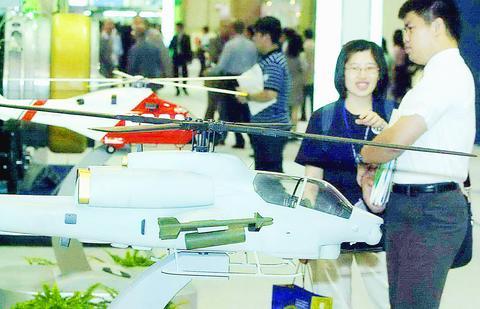The state-run Aerospace Industry Development Corporation (AIDC) will buy next year a new high-speed target drone for use by the three services in building anti-aircraft capabilities, the AIDC said yesterday.
A model of the US-made Voodoo drone is currently on display at the 2003 Taipei Aerospace Technology Exhibition (TATE) at the Taipei World Trade Center. It is one of the items that the AIDC showcases at the exhibition held every two years.
The AIDC said the Voodoo drone might not be the best of its kind but that it is much cheaper than top-end products of its category.

PHOTO: CHIANG YING-YING, TAIPEI TIMES
The Voodoo could be used by the three services for the practice of firing of missiles against aerial targets, mainly fighter planes.
The air force is likely to be the first user since it does not have a target drone of this kind for combat pilots to test-fire air-to-air missiles.
The air force has its own target drones, which have better capabilities but are much more expensive and fewer in number.
These high-end drones are often reserved by the air force for highly difficult missile tests, but are not enough in number for general practice by combat pilots.
An official with the AIDC said under the circumstances, the air force does need to have a lower-end drone for general practice.
"The Voodoo is a high-speed drone that could meet the air force's need for testing air-to-air missiles. It could also be used by the army and navy for the tests of their air defense missiles," the official said.
"If the three services have a great need for the drone, we could produce it in Taiwan under license from the original US manufacturer," he said.
The AIDC, the developer of the IDF fighter, now earns money from a diversity of businesses, including renting target drones to the three services for missile tests.
Besides the Voodoo, the AIDC has already bought a similar drone from Britain.
The British-made Banshee drone, which is lower in speed and cost, has been used by the army in the first round of the Hankuang No. 19 exercises in mid-May in Ilan. The second round of the exercises is to be held from Sept. 1 also in Ilan.
In the mid-May exercises, the army fired vehicle-mounted Stinger missiles against a Banshee launched from a mountain in Ilan.
A defense official, who has knowledge of the test results, said it was amazing that all the Stinger missiles missed the slow-flying Banshee. The Banshee was flying only at a speed of only 190kph.
"The missiles might have missed the target because the test was aimed at finding out whether they could achieve accuracy at their maximum range," the official said.
Also at yesterday's TATE, Bell Helicopter opened a press conference to introduce its newest product, the AH-1Z attack helicopter in an attempt to compete with the Boeing-made AH-64D Longbow Apache helicopter that the army is highly interested in buying.
It is generally believed that the army has already decided to buy the AH-64D.

SHIPS, TRAINS AND AUTOMOBILES: The ministry has announced changes to varied transportation industries taking effect soon, with a number of effects for passengers Beginning next month, the post office is canceling signature upon delivery and written inquiry services for international registered small packets in accordance with the new policy of the Universal Postal Union, the Ministry of Transportation and Communications said yesterday. The new policy does not apply to packets that are to be delivered to China, the ministry said. Senders of international registered small packets would receive a NT$10 rebate on postage if the packets are sent from Jan. 1 to March 31, it added. The ministry said that three other policies are also scheduled to take effect next month. International cruise ship operators

HORROR STORIES: One victim recounted not realizing they had been stabbed and seeing people bleeding, while another recalled breaking down in tears after fleeing A man on Friday died after he tried to fight the knife-wielding suspect who went on a stabbing spree near two of Taipei’s busiest metro stations, Taipei Mayor Chiang Wan-an (蔣萬安) said. The 57-year-old man, identified by his family name, Yu (余), encountered the suspect at Exit M7 of Taipei Main Station and immediately tried to stop him, but was fatally wounded and later died, Chiang said, calling the incident “heartbreaking.” Yu’s family would receive at least NT$5 million (US$158,584) in compensation through the Taipei Rapid Transit Corp’s (TRTC) insurance coverage, he said after convening an emergency security response meeting yesterday morning. National

PLANNED: The suspect visited the crime scene before the killings, seeking information on how to access the roof, and had extensively researched a 2014 stabbing incident The suspect in a stabbing attack that killed three people and injured 11 in Taipei on Friday had planned the assault and set fires at other locations earlier in the day, law enforcement officials said yesterday. National Police Agency (NPA) Director-General Chang Jung-hsin (張榮興) said the suspect, a 27-year-old man named Chang Wen (張文), began the attacks at 3:40pm, first setting off smoke bombs on a road, damaging cars and motorbikes. Earlier, Chang Wen set fire to a rental room where he was staying on Gongyuan Road in Zhongzheng District (中正), Chang Jung-hsin said. The suspect later threw smoke grenades near two exits

The Forestry and Nature Conservation Agency yesterday launched a gift box to market honey “certified by a Formosan black bear” in appreciation of a beekeeper’s amicable interaction with a honey-thieving bear. Beekeeper Chih Ming-chen (池明鎮) in January inspected his bee farm in Hualien County’s Jhuosi Township (卓溪) and found that more than 20 beehives had been destroyed and many hives were eaten, with bear droppings and paw prints near the destroyed hives, the agency said. Chih returned to the farm to move the remaining beehives away that evening when he encountered a Formosan black bear only 20m away, the agency said. The bear